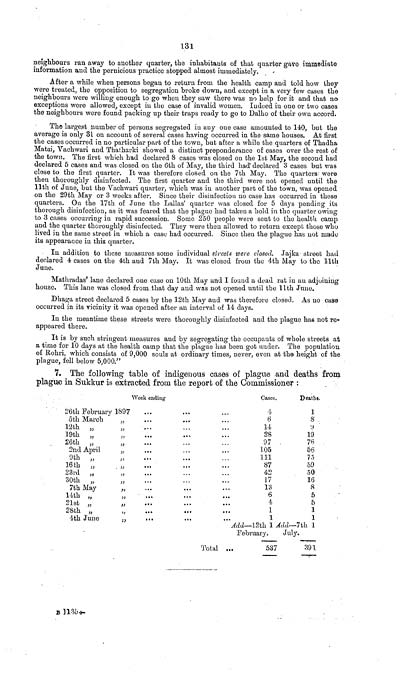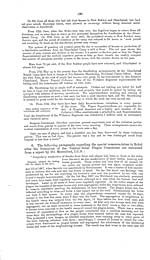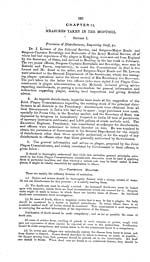Medicine - Disease > Account of plague administration in the Bombay Presidency from September 1896 till May 1897
(143) Page 131
Download files
Individual page:
Thumbnail gallery: Grid view | List view

131
neighbours ran away to another quarter, the inhabitants of that quarter gave immediate
information and the pernicious practice stopped almost immediately.
After a while when persons began to return from the health camp and told how they
were treated, the opposition to segregation broke down, and except in a very few cases the neighbours were willing enough to go when they saw there was no help for it and that no
exceptions were allowed, except in the case of invalid women. Indeed in one or two cases
the neighbours were found packing up their traps ready to go to Dalho of their own accord.
The largest number of persons segregated in any one case amounted to 140, but the average is only 31 on account of several cases having occurred in the same houses. At first
the cases occurred in no particular part of the town, but after a while the quarters of Thadha
Matai, Vachwari and Thatharki showed a distinct preponderance of cases over the rest of
the town. The first which had declared 8 cases was closed on the 1st May, the second had
declared 5 cases and was closed on the 6th of May, the third had declared 3 cases but was
close to the first quarter. It was therefore closed on the 7th May. The quarters were
then thoroughly disinfected. The first quarter and the third were not opened until the 11th of June, but the Vachwari quarter, which was in another part of the town, was opened
on the 29th May or 3 weeks after. Since their disinfection no case has occurred in these
quarters. On the 17th of June the Lallas' quarter was closed for 5 days pending its
thorough disinfection, as it was feared that the plague had taken a hold in the quarter owing
to 3 cases occurring in rapid succession. Some 250 people were sent to the health camp
and the quarter thoroughly disinfected. They were then allowed to return except those who
lived in the same street in which a case had occurred. Since then the plague has not made
its appearance in this quarter.
In addition to these measures some individual streets were closed. Jajka street had
declared 4 cases on the 4th and 7th May. It was closed from the 4th May to the 11th
June.
Mathradas' lane declared one case on 10th May and I found a dead rat in an adjoining
house. This lane was closed from that day and was not opened until the 11th June.
Dhaga street declared 5 cases by the 12th May and was therefore closed. As no case
occurred in its vicinity it was opened after an interval of 14 days.
In the meantime these streets were thoroughly disinfected and the plague has not re-
appeared there.
It is by such stringent measures and by segregating the occupants of whole streets at
a time for 10 days at the health camp that the plague has been got under. The population
of Rohri, which consists of 9,000 souls at ordinary times, never, even at the height of the plague, fell below 5,000."
7. The following table of indigenous cases of plague and deaths from
plague in Sukkur is extracted from the report of the Commissioner :
Week ending
Cases.
Deaths.
26th February 1897
4
1
5th March,,
6
8
12th ,,
14
9
19th ,,
28
19
26th ,,
97
76
2nd April,,
105
56
9th ,,
111
75
16th ,,
87
59
23rd ,,
42
50
30th ,,
17
16
7th May ,,
13
8
14th ,,
6
5
21st ,,
4
5
28th ,,
1
1
4th June ,,
1
1
Add-12th 1
Add-7th 1
February.
July.
Total ...
537
391
B 1135+
neighbours ran away to another quarter, the inhabitants of that quarter gave immediate
information and the pernicious practice stopped almost immediately.
After a while when persons began to return from the health camp and told how they
were treated, the opposition to segregation broke down, and except in a very few cases the neighbours were willing enough to go when they saw there was no help for it and that no
exceptions were allowed, except in the case of invalid women. Indeed in one or two cases
the neighbours were found packing up their traps ready to go to Dalho of their own accord.
The largest number of persons segregated in any one case amounted to 140, but the average is only 31 on account of several cases having occurred in the same houses. At first
the cases occurred in no particular part of the town, but after a while the quarters of Thadha
Matai, Vachwari and Thatharki showed a distinct preponderance of cases over the rest of
the town. The first which had declared 8 cases was closed on the 1st May, the second had
declared 5 cases and was closed on the 6th of May, the third had declared 3 cases but was
close to the first quarter. It was therefore closed on the 7th May. The quarters were
then thoroughly disinfected. The first quarter and the third were not opened until the 11th of June, but the Vachwari quarter, which was in another part of the town, was opened
on the 29th May or 3 weeks after. Since their disinfection no case has occurred in these
quarters. On the 17th of June the Lallas' quarter was closed for 5 days pending its
thorough disinfection, as it was feared that the plague had taken a hold in the quarter owing
to 3 cases occurring in rapid succession. Some 250 people were sent to the health camp
and the quarter thoroughly disinfected. They were then allowed to return except those who
lived in the same street in which a case had occurred. Since then the plague has not made
its appearance in this quarter.
In addition to these measures some individual streets were closed. Jajka street had
declared 4 cases on the 4th and 7th May. It was closed from the 4th May to the 11th
June.
Mathradas' lane declared one case on 10th May and I found a dead rat in an adjoining
house. This lane was closed from that day and was not opened until the 11th June.
Dhaga street declared 5 cases by the 12th May and was therefore closed. As no case
occurred in its vicinity it was opened after an interval of 14 days.
In the meantime these streets were thoroughly disinfected and the plague has not re-
appeared there.
It is by such stringent measures and by segregating the occupants of whole streets at
a time for 10 days at the health camp that the plague has been got under. The population
of Rohri, which consists of 9,000 souls at ordinary times, never, even at the height of the plague, fell below 5,000."
7. The following table of indigenous cases of plague and deaths from
plague in Sukkur is extracted from the report of the Commissioner :
Week ending
Cases.
Deaths.
26th February 1897
4
1
5th March,,
6
8
12th ,,
14
9
19th ,,
28
19
26th ,,
97
76
2nd April,,
105
56
9th ,,
111
75
16th ,,
87
59
23rd ,,
42
50
30th ,,
17
16
7th May ,,
13
8
14th ,,
6
5
21st ,,
4
5
28th ,,
1
1
4th June ,,
1
1
Add-12th 1
Add-7th 1
February.
July.
Total ...
537
391
B 1135+
Set display mode to: Large image | Zoom image | Transcription
Images and transcriptions on this page, including medium image downloads, may be used under the Creative Commons Attribution 4.0 International Licence unless otherwise stated. ![]()
| India Papers > Medicine - Disease > Account of plague administration in the Bombay Presidency from September 1896 till May 1897 > (143) Page 131 |
|---|
| Permanent URL | https://digital.nls.uk/74517296 |
|---|




